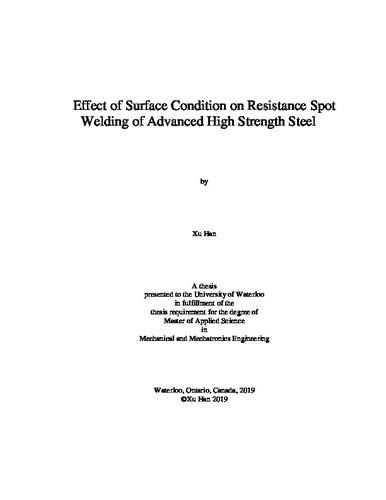UWSpace will be migrating to a new version of its software from July 29th to August 1st. UWSpace will be offline for all UW community members during this time.
Effect of surface condition on resistance spot welding of advanced high strength steel
| dc.contributor.author | Han, Xu | |
| dc.date.accessioned | 2019-09-25 14:36:19 (GMT) | |
| dc.date.available | 2019-09-25 14:36:19 (GMT) | |
| dc.date.issued | 2019-09-25 | |
| dc.date.submitted | 2019-08-29 | |
| dc.identifier.uri | http://hdl.handle.net/10012/15149 | |
| dc.description.abstract | Advanced high strength automotive sheet steel (AHSS) is used in body-in-white design to reduce vehicle weight while maintaining high crashworthiness. Surface coatings applied to AHSS to protect it from oxidation and decarburization during its processing and life cycle. Due to the characteristics of AHSS, including alloying content and thermal process requirements, a variation of final surface conditions is possible. The resistance welding process is affected by surface changes as it alters the electrical contact resistance. As a result, a change in resistance spot welding process window occurs. Without proper attention, this variation in the operation window could reduce the joint strength and results in an unpredictable failure by having an undersized nugget. In this study, two surface-related phenomena, internal oxidation, and zinc diffusion, were investigated to characterize their impact on resistance spot welding. Additionally, a heat input based electrical dynamic resistance approach was proposed to determine appropriate welding current given variations in the Zn diffusion layer resulting from heat treating during this hot stamping process for PHS steels. Promotion of internal oxidation is used in Zn galvanizing line to improve the wettability of the steel surface to the Zn pool via the enhancement of the reactive wetting. The presence of these internal oxides has shown to shift the weld lobe to higher currents, increasing the time required to generate an acceptable weld. Study of weld development showed that surface melting is responsible for this shift in the weld process window. The surface melting created a liquid contact surface between the faying surface, which reduced the electric contact resistance and heat generation at the weld faying surface. A smaller nugget was formed due to the reduction of heating. To compensate for this reduced heat generation, a higher welding current was required when RSW of internally oxidized samples. Zinc diffusion from the galvannealed coating to the steel substrate occurs when a galvannealed steel was exposed to elevated temperature during heat treatment in the press-hardening process. This formed a Fe-Zn diffusion layer. The thickness and composition of the diffusion layer were found to be dependent on heat-treatment conditions. With an increase in heat-treatment time, the electrical resistance of the steel sheet was observed to increase as well. With higher electrical resistance, less welding current was needed to weld the material. While a change in nugget size occurred when welding steels made using different heat-treatment conditions with constant welding parameters, the mechanical lap shear strength was not impacted. Martensite tempering in the heat-affected region was more severe in samples with a larger diameter weld nugget, which decreased the required stress for failure to occur, counter-acting the increase in strength gained from the larger nugget size. This work has shown that with a heat-treatment time ranging between 4 to 10 minutes, a robust resistance welding schedule can be determined to generate a mechanically sound weld. Dynamic electrical resistance has been used to monitor the weld quality. Heat input analysis was shown to reflect the weld development as it takes into account the full weld cycle. Heat input has shown to have a linear correlation with nugget size. Undersized nugget can be successfully detected and corrected by changing the welding current based on the heat input value calculated from dynamic resistance measurement. | en |
| dc.language.iso | en | en |
| dc.publisher | University of Waterloo | en |
| dc.subject | resistance spot welding | en |
| dc.subject | dynamic resistance | en |
| dc.subject | advanced high strength steel | en |
| dc.subject | surface condition | en |
| dc.subject | weld quality monitoring | en |
| dc.title | Effect of surface condition on resistance spot welding of advanced high strength steel | en |
| dc.type | Master Thesis | en |
| dc.pending | false | |
| uws-etd.degree.department | Mechanical and Mechatronics Engineering | en |
| uws-etd.degree.discipline | Mechanical Engineering | en |
| uws-etd.degree.grantor | University of Waterloo | en |
| uws-etd.degree | Master of Applied Science | en |
| uws.contributor.advisor | Zhou, Norman | |
| uws.contributor.advisor | Biro, Elliot | |
| uws.contributor.affiliation1 | Faculty of Engineering | en |
| uws.published.city | Waterloo | en |
| uws.published.country | Canada | en |
| uws.published.province | Ontario | en |
| uws.typeOfResource | Text | en |
| uws.peerReviewStatus | Unreviewed | en |
| uws.scholarLevel | Graduate | en |

